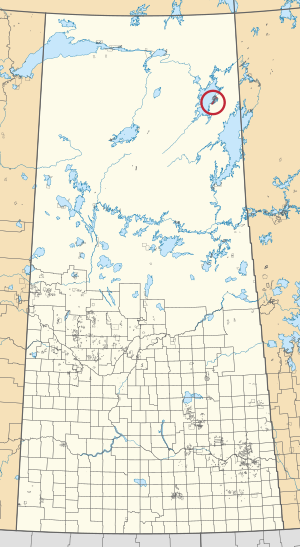Lac la Hache 220 facts for kids
Quick facts for kids
Lac la Hache 220
|
|
|---|---|
| Lac la Hache Indian Reserve No. 220 | |

Location in Saskatchewan
|
|
| First Nation | Hatchet Lake |
| Country | Canada |
| Province | Saskatchewan |
| Area | |
| • Total | 11,020 ha (27,230 acre) |
| Population
(2016)
|
|
| • Total | 1,377 |
| Community Well-Being Index | 37 |
Lac la Hache 220 is a special place in Saskatchewan, Canada. It is an Indian reserve that belongs to the Hatchet Lake Denesuline First Nation. Think of it as their traditional homeland. This reserve is located far north, about 354 kilometres from a town called Flin Flon.
Contents
Discovering Lac la Hache 220
Lac la Hache 220 is one of the many Indian reserves in Saskatchewan. These lands are set aside for the use and benefit of First Nations people. They are very important for preserving their culture and way of life.
What is an Indian Reserve?
An Indian reserve is a piece of land in Canada that is managed by a First Nations group. These lands are protected for the use of Indigenous communities. They help keep their traditions and communities strong.
The Hatchet Lake Denesuline First Nation
Lac la Hache 220 is the home of the Hatchet Lake Denesuline First Nation. The Denesuline people are part of the larger Dene language group. They have lived in this area for a very long time. Their history and culture are deeply connected to the land.
Population and Community Life
In 2016, a special count called the 2016 Canadian Census took place. It showed that 1,377 people lived in Lac la Hache 220. They lived in 260 homes. This shows a lively community with many families.
Understanding Community Well-Being
The Community Well-Being Index is a way to measure how well a community is doing. It looks at things like health, education, and income. In 2016, Lac la Hache 220 had an index of 37 out of 100.
This number can be compared to other communities. The average for First Nations communities was 58.4. For non-Indigenous communities, the average was 77.5. This index helps us understand the challenges and strengths of different communities.

